Mazda CX-5 2.2 SE-L NAV
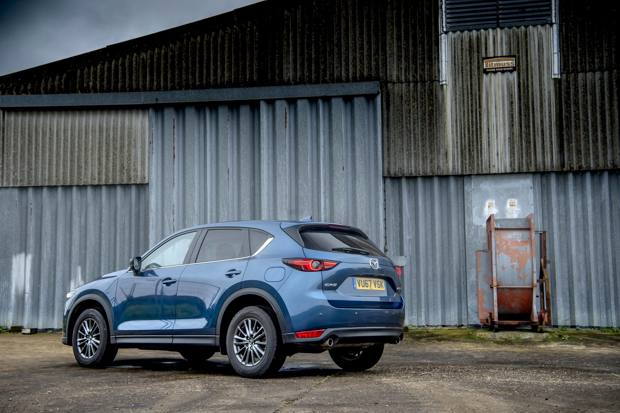
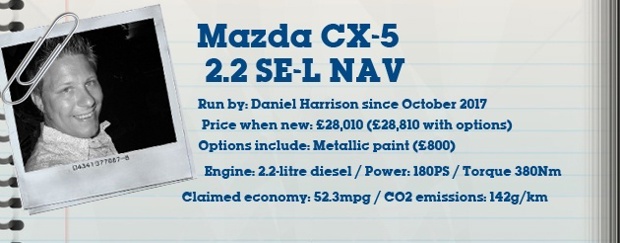
Introducing the second generation Mazda CX-5
The CX-5 has been something of a runaway success for Mazda, with many happy owners. How will this latest model fare?

Date: 9 October 2017 | Current mileage: 586 | Fuel consumption: 41.5mpg
We can’t be on the second generation of the CX-5 already can we? It seems like it was just the blink of an eye ago that Mazda was launching its popular and thoroughly decent alternative to the Nissan Qashqai.
A quick check of the calendar - and my own memory - confirms that, yes, we’re now in the era of CX-5 2.0 (and by that I do mean MK2, not a 2.0-litre engine. Though there is a 2.0-litre engine - more on that later). Out of every five Mazdas to leave showrooms in the past five years, two have been CX-5s, so this new one will no doubt be hotly anticipated by existing owners.
So, what are the key differences? Well, it’s not baby-out-with-the-bathwater territory, but you’ll notice that the styling has been sharpened-up with the shark-like grille and super-slim headlights. Big changes come in the areas that you can’t see - especially in refinement and sound deadening - so much in fact that it’s 50kg heavier than before. There’s also upgrades for the engine and additional kit that was becoming standard-fit for cars of a similar size and price.
And that’s important, as the The CX-5 now exists in a much more sophisticated landscape to the original car. The large crossover is now the default family car with almost every manufacturer offering something. And you can take your pick of some truly exceptional cars. As well as the venerable Qashqai, SEAT has its Ateca (our car of the year 2017), Ford the Kuga and Peugeot the new 3008. After something with a snazzier badge? Then there’s options from Audi, Mercedes-Benz and BMW. On more of a budget? Then there’s Ssangyong and Dacia. All of them offering superb cars at their various price points.
So, competition from every angle. The CX-5 is capable of holding its own, though. The previous generation was good to drive and that should be carried over and, while it isn’t cheap, it does represent good value on paper.
With that in mind, I’ve opted for the SE-L, as you get plenty of useful equipment such as cruise control, front and rear parking sensors and automatic lights and wipers. The next trim up has its sights firmly on German premium territory with toys such as heated seats and steering wheel, a head-up display, fully electric leather seats, a powered tailgate and keyless entry. Nice to have? Maybe. Worth paying the extra for? I’m not so sure…
Options-wise, I’ve gone for Deep Crystal Blue metallic. And that’s it. It’s an £800 extravagance, but pretty much all colours these days will cost you.
That means that this CX-5 clocks-in at £28,010, which compares favourably to the likes of the SEAT Ateca and Ford Kuga (£30,010 and £29,490 respectively). And when it comes to an Audi Q5 - you’ll be looking at in excess of £40,000 to achieve the same kind of spec.
Power comes from a 2.2-litre diesel. Controversial in the current climate, but I feel it’s the best engine for the CX-5. There are two states of tune: 150PS and 175PS and I’ve gone for the lower output. It has more punch than the the 2.0-litre petrol (which although more powerful - with 165PS - doesn’t deliver its power as eagerly). All of these engines have been carried over from the old CX-5, but are said to have been improved considerably when it comes to vibrations and resonance - especially the diesel when it’s idle.
The impact of that extra weight has had a negative effect on CO2 emissions - though with changes to road tax, this is becoming less of a concern for private buyers. The 150PS 2.2-litre diesel will emit 142 g/km CO2, though Mazda is confident that it equates to a real-world 53mpg. We’ll see on that score when Real MPG results start to roll in from readers. The previous generation was a mixed bag, with some models as high as 86% of the official figure and the lowest coming in at 77%. In theory, Mazda’s improvements should see an improvement on this.
We like Mazdas here at HonestJohn.co.uk. Not only from our own experience, but what’s reported from you - our readers. Well built, good to drive and well equipped is a summary of what we usually hear - all of which I’ll be bearing in mind during my time with this CX-5.
Put to the MoT test
Our latest analysis on every MoT conducted in 2016 has a bit of a surprise in store for the CX-5.
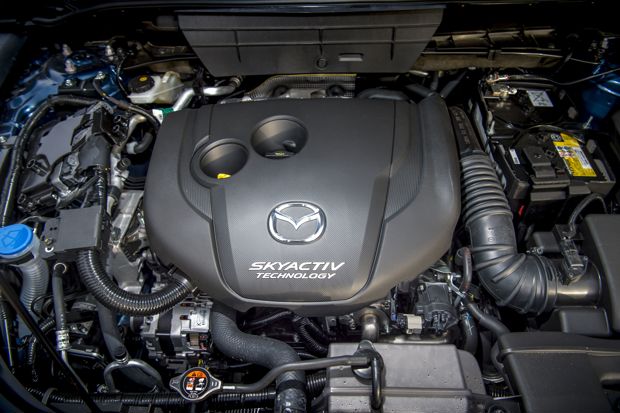
Date: 7 November 2017 | Mileage: 1298 | Fuel consumption: 42.3mpg
We’ve recently published the latest set of MoT Test results, covering all tests carried out up until 2016. It’s a huge dataset, which gives unparalleled insight into which cars are likely to pass their test - and what they fail on if they don’t. If you’re unfamiliar with the work that we’ve been doing since 2012 in opening up previously-hidden MoT Test results to the public, you can get the full story here.
Obviously this won’t cover my CX-5, which is second generation and only registered this year, but our research into MoT data does give an indication of how it may perform in future based on what the performance of Mazda as a manufacturer and the first generation CX-5 in particular - and that accounts for tens of thousands of cars.
And the outlook is good. Our research shows that the CX-5 has the third-highest MoT pass rate with 89.2 per cent passing their MoT - only Audi’s Q3 and the Vauxhall Mokka have a better score. Close to 8000 were tested in 2016 - many of those being the first MoT - so this is a very strong, impressive, performance indeed.
So, what will you see a Mazda CX-5 fail on? Dig deeper into the stats and you’ll see that the biggest area for failure was tyres - 3.5 per cent of cars presented for the MoT test came a cropper on this. So, although it might appear to be a bit of a cliche to check the depth and condition of your tyres before the test (and regularly anyway as a matter of course), it could be the difference between pass and fail. It’s one of those areas that’s almost exclusively down to the owner, not the manufacturer.
Brakes come in second at 2.8 per cent - again an area that falls under maintenance, while lamps, reflectors and electrical equipment account for 2.4 per cent. After 2.3 per cent of failures for driver’s view of the road (take down those air fresheners hanging from the rear-view mirror), there are almost no other reasons for failure - which is remarkable. Not a single CX-5 failed for steering or seatbelt issues and only 0.1 per cent failed on body structure and road wheels.
But what about higher mileage cars? This is where things start to get even more impressive and really start to demonstrate the CX-5’s potential longevity. Lower-mileage models perform-in line with expectations. At 10-20,000 miles 94.3 per cent of CX-5s will pass the test (against an all-model average of 86.9 per cent) and at between 20-30,000 miles it’s 90.7 per cent (against the all-model average of 82.3 per cent). But whereas the drop-off in pass rates accelerates on the all-model average when you get to 90-100,000 miles, it remains impressively steady for CX-5. There’s a drop of just 8.7 per cent between a 10,000 mile car and one that has covered 100,000 miles. Conversely, the average 100,000 mile car will have a pass rate of just 54 per cent - a drop of 33 per cent cent on a 10,000-mile car.
As a manufacturer, Mazda impresses too. Taking all of its models registered between 1980 and 2014 and tested in 2016, it comes out with a 67 per cent pass rate from 464,647 MoT tests. The top three reasons for failure are: lamps and lighting (13.5 per cent), suspension (11.5 per cent) and brakes (9.6 per cent). It should be remembered that many of the older nineties cars tested will be imported Eunos Roadsters and Bongos which are, ahem, of varying quality. They’re likely to have issues arising from being imported and potentially not looked after as well as they may well have been that that will be pulling down the average. Bongo’s pass rate is just 50 per cent. On the whole, Mazda classics are well looked after - a 1985 car has a better pass rate than a 2008 car.
It just goes to demonstrate that second generation CX-5 owners should have nothing to fear on their first MoT - provided they’ve done a few checks for themselves. Click here for all the stats on CX-5 MoT tests.
What impact have the updates had to the way the CX-5 drives?
Despite looking very similar to the outgoing model, Mazda has put much thought into improving the driving experience - but how does it stack up?
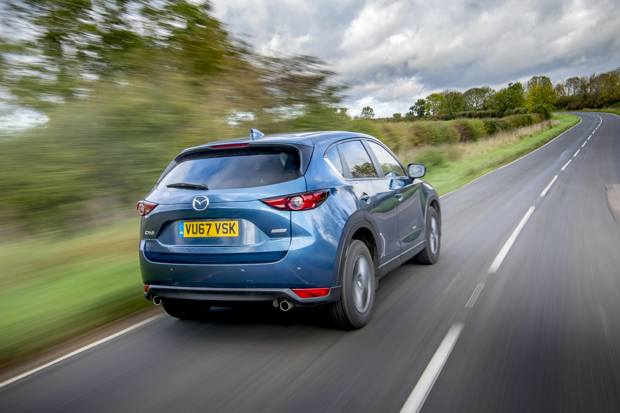
Date: 17 January 2018 | Current mileage: 2347 | Fuel consumption 42.8mpg
The CX-5 has always been one of the best crossovers of this size to drive, better in fact than many of Mazda’s standard hatchbacks against their rivals.
Set up to have some of the flair that you’d expect from their MX-5, the CX-5 has always offered a much more engaging drive than - for example - the Nissan Qashqai. In diesel form, it’s always been quick-off-the-mark with quick, accurate cornering and the ability to carry speed through corners with little in the way of bodyroll. The downside to that, of course, is that the suspension set up has always been a little firmer - but that’s something that’s true of many Mazda’s in the range.
The new car is no different and you can really see where those incremental improvements have been made. The body is stiffer and that means the handling is further improved. You can feel how bodyroll is better controlled - impressively so for a car of this size and shape - and how it’s more surefooted through corners. From behind the wheel, you get the feeling that you’re driving nothing larger than a large hatchback. Although the driving position is raised, giving a good view of the road ahead, you’re never left with the impression you’re something this large. That MX-5 quality that I mentioned earlier really shines through on this new car, particularly in the steering and crisp, clean gearchanges. It’s a flavour of sportiness that’s missing from many other large crossovers and rather surprising the first time you’re out on the road.
Mazda will tell you that is in part to do with the introduction of new “SKYACTIV-VEHICLE DYNAMICS” (its capitals, not mine…). This rather shouty name is the catch-all term for a suite of tech that’s already been used on Mazda 2, CX-3 and Mazda 6 and is now making its debut on CX-5. Key to this is G-Vectoring control, which is said to “integrate control of the engine, transmission and chassis to enhance the connection between car and driver and, GVC varies engine torque to optimise vehicle dynamics. By monitoring steering and throttle position when entering a corner under power, GVC momentarily reduces the amount of torque delivered to the front wheels, thereby transferring a fraction more weight onto the front axle. This increases front tyre grip, which allows the front wheels to turn more precisely.” In English, this means that ignition is paused when sensors determine the steering wheel is being turned at the same time the vehicle is moving at speed.
Hands-up - I wouldn’t be able to tell you it’s there unless I knew already, but it does help add to the impression that as much thought has gone into making the CX-5 engaging to drive as has making it a practical family hold-all. I don’t think Mazda expects you to notice, either. It also states “The indiscernible nature of GVC means that the driver subconsciously reduces any unnecessary steering and throttle movements through the corner. Even on a straight road, GVC can reduce driver fatigue and increase passenger comfort by removing the perceived need for the countless tiny corrections that some drivers make when driving straight. In doing this, GVC lowers driver effort and reduces the amount of head and body sway small steering corrections can create for passengers.”
Another area where much attention has been paid for this MKII CX-5 is the refinement. Again, this really comes over when you’re out on the open road and on the motorway in particular. Like the G-vectoring Control, it’s not something that you can put your finger on, you’re not going to be thinking “WOW, this sound deadening is AMAZING” at any point, but you are likely to pick up - after a while - that it really is a quiet cabin. The suppression of engine noise is especially impressive to me - all of the harsh notes under acceleration are filtered out and road noise is unnoticeable.
So, whether it’s out on the road or, from behind the wheel, these upgrades to the CX-5 really shine through, even though you wouldn’t necessarily notice from the outset that they are there.
How much does it cost to insure a Mazda CX-5?
Insurance is one of the most significant costs of owning a car - so what does that mean for the CX-5?

Date: 13 February 2018 | Current Mileage: 3976 | Fuel consumption: 43.1mpg
Ongoing costs are one of the biggest questions you face when buying a new car. Will it be cheaper than my current car? More expensive? Or about the same.
The big three that will be at the back of everyone’s minds are road tax (or VED to be precise), insurance and servicing costs.
But for this update, let's take a look specifically at insurance costs.
Mazda had quite a coup back in 2012 when it came to insurance costs. The decision to make its ‘active' safety technology - which helps drivers avoid accidents or reduce the severity of collisions - standard fit across the board knocked the model down several insurance groups.
This kit included Mazda's ‘Smart City Brake Support' (SCBS), which was standard-fit across the CX-5 range. The ABI (Association of British Insurers) decided to lower the original insurance group ratings for CX-5 by two groups across the 18-strong line-up.
Fast forward to 2017 and things have moved on. As you’d expect, it still has SCBS, which has now been expanded to have a detection distance and a widened view angle. The forward detection speed range has grown from 2-19mph to 2-50mph and it can also detect pedestrians within a speed range of 6-50mph.
It’s now part of a Mazda’s i-ACTIVESENSE technologies, which include Adaptive LED Headlights (an £800 option on Sport Nav diesel models and radar cruise control (an £800 option on 175PS Sport Nav Auto models in conjunction with the Safety Pack).
This, combined with a strong bodyshell, meant that the CX-5 performed particularly well in the Euro NCAP crash test, scoring five stars overall, plus 95 per cent for occupant safety, 80 per cent for child occupant safety, 78 per cent for pedestrian safety and 59 per cent for safety assist.

So, it’s not surprise to see that there’s been very little change in insurance grouping for the 2017 CX-5, despite time moving on and the goalposts changing. The range comes in between Insurance Groups 15 and 21 - exactly where they were before.
Mazda CX-5 (2012 - 2016) Insurance Groups
|
Version |
Group (1-50) |
|
|
2.0 SE-L 165 5dr |
SUV |
15 |
|
2.0 SE-L 2WD 5dr |
SUV |
15 |
|
2.0 SE-L Nav 2WD 5dr |
SUV |
15 |
|
2.0 Sport 2WD 5dr |
SUV |
16 |
|
2.0 Sport Nav 2WD 5dr |
SUV |
16 |
|
2.2 SE-L 150 5dr |
SUV |
18 |
|
2.2 SE-L 150 Auto 5dr |
SUV |
18 |
|
2.2 SE-L 150 AWD 5dr |
SUV |
17 |
|
2.2 SE-L Auto 150 AWD 5dr |
SUV |
17 |
|
2.2 SE-L Lux 150 5dr |
SUV |
20 |
|
2.2D SE-L 2WD 5dr |
SUV |
18 |
|
2.2D SE-L 2WD Auto 5dr |
SUV |
18 |
|
2.2D SE-L AWD 5dr |
SUV |
17 |
|
2.2D SE-L AWD Auto 5dr |
SUV |
17 |
|
2.2D SE-L Lux 2WD 5dr |
SUV |
20 |
|
2.2D SE-L Lux Nav 2WD 5dr |
SUV |
20 |
|
2.2D SE-L Nav 2WD 5dr |
SUV |
18 |
|
2.2D SE-L Nav 2WD Auto 5dr |
SUV |
18 |
|
2.2D SE-L Nav AWD 5dr |
SUV |
17 |
|
2.2D SE-L Nav AWD Auto 5dr |
SUV |
17 |
|
2.2D Sport 2WD 5dr |
SUV |
19 |
|
2.2D Sport AWD 5dr |
SUV |
21 |
|
2.2D Sport AWD Auto 5dr |
SUV |
21 |
|
2.2D Sport Nav 2WD 5dr |
SUV |
19 |
|
2.2D Sport Nav AWD 5dr |
SUV |
21 |
|
2.2D Sport Nav AWD Auto 5dr |
SUV |
21 |
Mazda CX-5 (2017 on) Insurance Groups
|
Version |
Group (1-50) |
|
|
2.0 SE-L Nav 2WD 5dr |
SUV |
15 |
|
2.0 Sport Nav 2WD 5dr |
SUV |
16 |
|
2.2D SE-L Nav 2WD 5dr |
SUV |
18 |
|
2.2D SE-L Nav 2WD Auto 5dr |
SUV |
18 |
|
2.2D SE-L Nav AWD 5dr |
SUV |
17 |
|
2.2D SE-L Nav AWD Auto 5dr |
SUV |
17 |
|
2.2D Sport Nav 2WD 5dr |
SUV |
19 |
|
2.2D Sport Nav 2WD Auto 5dr |
SUV |
19 |
|
2.2D Sport Nav AWD 5dr |
SUV |
21 |
|
2.2D Sport Nav AWD Auto 5dr |
SUV |
21 |
But, as well all know, insurance groupings are advisory and insurance companies can pretty much charge what they like, based on risk and how competitive they want to be in certain markets at certain times of the year.
We’ve put together some sample quotes on what a new CX-5 could cost you to insure - as a very rough guide.
These are just examples and we've made a lot of assumptions. Your circumstances will be different - so make sure you check to see what it will cost you. We've used Confused.com for these sample quotes*.
|
Bell |
Elephant |
Diamond |
Admiral |
LV |
|
|
18 Year old |
No quote |
No quote |
No quote |
||
|
25 year old |
£909* |
£910* |
No quote |
£751* |
|
|
45 year old |
£744* |
£815* |
£819* |
No quote |
£332* |
The cheapest quotes for an 18 year old was a black box policy: Hastings (£1357)*
The cheapest quotes for a 25 year old was Hastings Direct (smart miles) (£725)*
The cheapest quotes for a 45 year old was LV (£332)*
From the quotes above, it’s not really a surprise to see an 18 year old clobbered for driving a 2.2-litre diesel CX-5. Whatever younger people drive, they’re hit with huge insurance bills and in this case it’s a demonstration that the insurance companies REALLY don’t want them driving a £30,000 big diesel. What’s notable, though, is how that cost drops dramatically by the time the driver reaches 25. And what you can’t see from the table above is the breadth of insurance companies offering cover. At 18 there isn’t much choice at all and many specialist providers, but by the time you get to 25 the list is full of household names. Add on another 20 years and the costs really start to look reasonable. We saw quotes from £421 and a broad range of household names offering cover.
These are, of course, just samples designed to give you a flavour of costs. You should do your own research, too, based on your own circumstances which will be different to these examples. You can get a quote from MoneySupermarket here*.
What’s the feeling among owners about the the CX-5?
Thumbs-up or thumbs-down from readers on HonestJohn.co.uk?
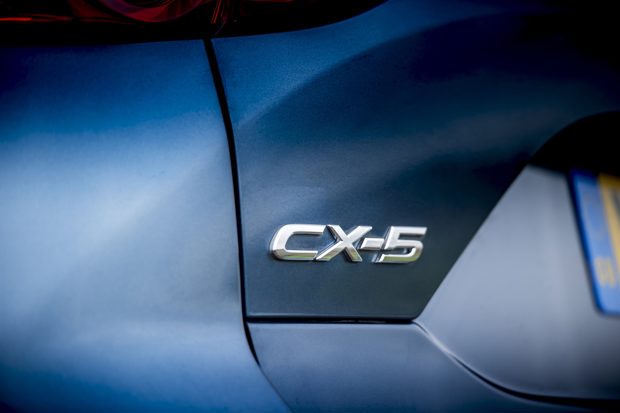
Date: 21 March 2018 | Current Mileage: 4829 | Fuel consumption: 43.4mpg
At HonestJohn.co.uk we’re continuously looking from owners on their cars - what they like, what they don’t, what the fuel consumption is like and what’s gone wrong.
One of the ways that we do that is through our owner reviews. These give a real sense of what it’s like to live with a car and the more that we get, the more accurate picture we can build about a certain model - warts ‘n all. You can leave a review for your own car here.
So, what do out owner reviews tell us about the CX-5?
If we start with the previous 2012-2017 model CX-5, we’ll see a car that scores 4.1 out of five and is generally we received by its owners. Of the 17 reviews that have been submitted, 12 rate it as either 4.0 or 5.0 (out of five) and only one gives it a 1.0 - the lowest possible score.
Comfort and quality are two of the themes that users return to again and again in these review. One user states: “We’re into CX-5 number two after buying the first one in 2012. Will drive the competition, but will probably buy the new model CX-5 shortly-as an all round suv, for less than £30k there’s nothing comes close for sense of fun, reliability,economy or standard fit equipment. Keep it up Mazda”, while another says: “Spacious, comfy, well-built. Handles nicely despite size. Very full spec despite being basic model. Achieving around 40mpg overall which is reasonable for petrol engined SUV. Pleasantly surprised to discover how cheap insurance is (apparently due to the laser auto-brake). Gearbox is a little more solid than my previous RAV4, but soon becomes familiar.” A further reader, also gives full marks: “This car is extremely comfortable long journeys are a pleasurable - Fuel economy is great and improved after first 2000 or so miles of ownership. ”
It’s a similar story for the current 2017-on model. Though we’ve only had two reviews submitted, so at the time of writing there was one glowing review and one not so glowing, giving an average score of 3.0. The review with the 5.0 rating says: “Very comfortable; Quiet; Easy to get In/Out; Economic. Electric Handbrake once mastered is good & the Hold/Hill start assist is excellent.”
It’s cancelled out by a rating of just 1.0 and although the first two words are “Great package”, it’s followed by “shame”. It’s clear that this reader has a long and ongoing issue with the car and the response that he’s received from Mazda UK:
“Our first Brand New CX-5 Diesel Automatic, but not our first new Mazda, we have had 2 New MX-5's and a new Mazda3 diesel manual that we had for 3 years giving us no problems whatever, leading us to go for the CX-5 Diesel as a result, plus our second-hand MX5, Mk3-.which we still have and love to bits.
The CX-5, initially, it was absolutely superb having had a fantastic makeover outside along with a sumptuous leather interior being a 2 fwd automatic which we took on our first long trip to the Jurassic Coast, For a high riding SUV we achieved a really good MPG around 50 MPG and was, after the 3 found to be a much quieter driver/passenger compartment. So far so good.
In May 2018 and 2270 miles on the odometer my wife started the CX-5 up at our home address and to my horror it started on 3 cylinders with such a mechanical rattle I expected an imminent catastrophic failure prompting me to tell her nibs to shut it down.
She then informed me it had done this once before at the car park where she worked prompting 3 of her work colleagues some fifty feet away to look on in astonishment due to the noise made on start up
The CX-5 was uplifted to the Garage we purchased it from via Mazda Assist where it was investigated and found by the computer ....No Faults.
I was not surprised as this was a mechanical problem NOT an electronic one, being somewhat cynical I have vidoe'd each start-up from cold since this has happened in which out of 11 starts she has made 4 three cylinder starts with various levels of noise attached.”
Our advice here would be to try to work things out as much as you can with the dealer first, before involving the manufacturer’s head office. If that fails and you still think you have a problem car - you then have grounds to reject it. But make sure you’ve gone through the proper channels first - it will significantly strengthen your case.
How does the CX-5 hold up in a heatwave?
As temperatures top 30 degrees, how does the CX-5 cope?
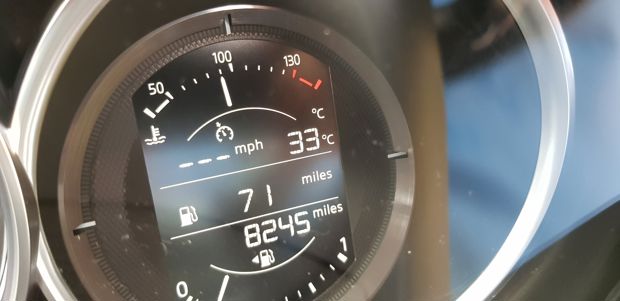
Date: 17 July 2018 | Current Mileage: 7827 | Fuel consumption: 43.9mpg
This year has seen one of the longest unbroken spells of hot and sunny weather in living memory - a real contrast from The Beast From The East earlier in year.
But what do these extremes of knee-high snow in March and mid-thirties temperatures in July mean for the CX-5?
Well, it’s happy with both. Back in March, the decent ride height and chunky tyres helped out in the snow and now some of the CX-5’s other qualities are coming to the fore as the mercury rises.
In mid-July we’re in the kind of territory where when you leave the office at the end of the day and get in the car it’s like getting into a greenhouse on wheels. Those big windows on the CX-5 may give great visibility and may be tinted for privacy, but they do an efficient job of heating it up during the day. During late July it hasn’t been unusual to see 35 degrees on the thermometre on the dash - and it feels like it too.
The dark interior of the CX-5 absorbs that heat, too - the dash, steering wheel and instruments are all hot to the touch when you first get in. But it does cool quickly if you use the standard procedure of winding windows down and cranking up the air con up to full blast. It needs a good five or ten minutes, but the temperature soon comes down to a more comfortable level. I’ve found that for outside temperatures around 30 degrees the fan speed needs to be a full notches down from full blast to maintain a comfortable temperature for those in the front and passengers in the rear. In spite of the increased air conditioning use, I haven’t really seen any difference in fuel consumption - remaining at a steady 43.9mpg.
The lack of rain this year has been welcome when it comes to outdoor events - and this is where I was expecting the CX-5 to come into its own. In years gone by, torrential downpours at festivals and outdoor events have turned field car parks into quagmires. As May turned to June, I’d been expecting to get a taste of this myself with the CX-5 (after all this is the time of year when Glastonbury is on - as famous for its mud baths as its bands), but not a bit of it. I’d expected the same qualities that helped it in the snow in March to get it out of muddy fields at events. But, none of it - the blazing summer has meant that grass has been short and mud has been baked to concrete-like hardness. There’s been little difference between parking on this and a tarmaced car park…
And at those events, the sheer space and flexibility of CX-5 continues to impress. Whether it’s an airshow where picnics, camping chairs, trolleys and the like are needed or a weekend away that requires a couple of small cases, there’s plenty of room on offer. The CX-5’s rear bench splits and fold 40:20:40, which is ideal when there’s longer items. With both seats down, there’s a huge amount of space. You’ll have no problem with four large suitcases and other assorted bags and luggage.
Of course, nothing lasts forever and those long, hot summer days were brought to an abrupt close at the end of July. This can mean treacherous conditions on the roads, as the debris that’s been sitting on top of the tarmac for several months can cause ice-like conditions. And that’s before you consider the flash floods and surface water caused by overwhelmed drains and the baked-solid ground that struggles to absorb the rainwater. Once again, the CX-5 doesn’t put a foot wrong - the wipers may be maxxed-out as a torrential storm, but the on-road performance remains strong - a feeling that’s aided by good forward visibility.
With such all-round ability, flexibility and sure-footedness in adverse conditions, it’s no surprise that crossovers have become so popular in recent years - and it shows no signs of letting up.
Time for a change already?
After little more than 12 months on sale, there's some nips-and-tucks for the second generation CX-5
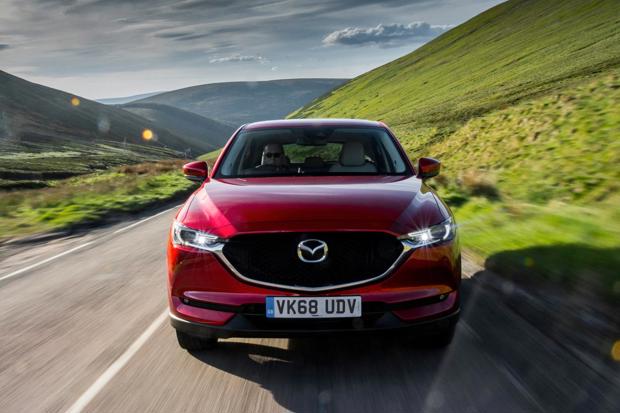
Date: 8 August 2018 | Current Mileage: 8276 | Fuel consumption: 44.2mpg
It may be little more than a year since the second-generation CX-5 went on sale, but already the winds of change are blowing.
Mazda has updated the CX-5 with changes to the 2.2-litre diesel engine (the same engine that powers my car), increased active safety equipment across the range (which will do no harm to those insurance costs that I mentioned here) and, for the first time, the introduction of an automatic petrol model.
The CX-5 is now the best-selling Mazda in the UK and since June 2017 more than 3600 of them have been registered.
This updated version is on sale from the end of this month (31 August to be precise) and sees 10 derivatives now make up the CX-5 model range with SE-L Nav+ and Sport Nav+ trim levels. Unchanged is the availability of Mazda’s SKYACTIV six-speed manual and SKYACTIV six-speed automatic transmissions and the option of i-ACTIV all-wheel drive. Added to that is a 165ps SKYACTIV 2WD automatic - the first time that you’ve been able to match a petrol engine to an automatic gearbox in a CX-5 in the UK. This front-wheel drive 2.0-litre 165ps SKYACTIV-G petrol engine is available in SE-L Nav+ and Sport Nav+ trim.
The 2.2-litre 150ps SKYACTIV diesel that powers my CX-5 is the mainstay of the range, so it’s no surprise to see that that Mazda claims it has also been enhanced with a modified combustion chamber, new piezo injectors, a revised two-stage turbocharger and a Selective Catalytic Reduction (SCR) System. Mazda says that the engine adopts rapid multi-stage combustion with ultra-high response piezo injectors, while a revised combustion chamber minimises heat transition between the fuel and piston to improve efficiency. Changes to the water flow management help the engine warm up quicker to reduce emissions and Adblue has been introduced. This applies to both power outputs of the 2.2-litre engine.
Speaking of which, the higher output 2.2-litre has just got that bit beefier with engine power rising from 175PS to 184PS and torque increasing 25Nm to 445Nm. There’s also a new two-stage twin turbo that adopts variable geometry that increases boost from mid to high revs improving power and torque.
There’s little to report on exterior styling changes, aside from a new design of 19-inch Metallic alloy wheel on Sport Nav+.
Inside, there’s some minor changes. All models feature LED headlights, auto power-folding door mirrors, dual-zone climate control, DAB radio and a 7-inch colour touch-screen display with Mazda’s integrated navigation. Sport Nav+ cars add to this with a reversing camera, eight-way power adjustable driver’s seat and Smart keyless entry, plus heated front seats and steering wheel. New for 2018 on Sport Nav+ models is a power lift tailgate and a a new heads-up display that projects directly onto the windscreen and features Traffic Sign Recognition.
Additional safety equipment is the other big news with Mazda Radar Cruise Control, Advanced Blind Spot Monitoring with Rear Cross Traffic alert, Smart Brake Support, High Beam Control and Lane Keep Assist with Lane Departure Warning now standard across the range. A360 view camera and Adaptive LED Headlamps are now part of an optional safety pack on Sport Nav+ models.
While the winds of change blowing through these updates may be more of a light Summer breeze than anything that will trouble the Beaufort Scale, it does offer tangible - if incremental - improvements on the car that’s been on sale since June 2017.
Pricing and emissions of 2018 Mazda CX-5
|
SKYACTIV-G Petrol |
‘On the road’ (OTR) Retail Price |
CO2 Emissions |
Difference in CO2 from outgoing car |
|
Mazda CX-5 2.0 165ps 2WD SE-L Nav+ |
£24,795 |
146 |
-3 |
|
Mazda CX-5 2.0 165ps 2WD SE-L Nav+ Auto |
£26,295 |
150 |
N/a |
|
Mazda CX-5 2.0 165ps 2WD Sport Nav+ |
£28,295 |
146 |
-3 |
|
Mazda CX-5 2.0 165ps 2WD Sport Nav+ Auto |
£29,795 |
150 |
N/a |
|
SKYACTIV-D Diesel |
|||
|
Mazda CX-5 2.2 150ps 2WD SE-L Nav+ |
£26,695 |
130 |
-2 |
|
Mazda CX-5 2.2 150ps 2WD SE-L Nav+ Auto |
£28,495 |
143 |
-4 |
|
Mazda CX-5 2.2 150ps 2WD Sport Nav+ |
£29,695 |
130 |
-2 |
|
Mazda CX-5 2.2 150ps 2WD Sport Nav+ Auto |
£31,495 |
143 |
-4 |
|
Mazda CX-5 2.2 184ps AWD Sport Nav+ |
£34,395 |
137 |
-5 |
|
Mazda CX-5 2.2 184ps AWD Sport Nav+ Auto |
£34,395 |
147 |
-5 |
